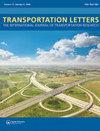Vehicle detection in diverse traffic using an ensemble convolutional neural backbone via feature concatenation
IF 3.3
3区 工程技术
Q2 TRANSPORTATION
Transportation Letters-The International Journal of Transportation Research
Pub Date : 2024-09-13
DOI:10.1080/19427867.2023.2250622
引用次数: 0
Abstract
Nowadays, deploying an intelligent vehicle detection system (IVDS) in diverse traffic is a work priority. It provides real-time traffic information with vehicle counts and types of vehicles. IVDS deployment in diverse traffic is challenging because different vehicle classes occlude each other on the road. In recent years, convolutional neural network (CNN) based deep learning (DL) methods have attained incredible progress in implementing IVDS. However, most CNN-based DL methods do not include diverse traffic conditions in Asian countries. Also, due to existing feature extraction backbones, they cannot accurately detect multi-scale vehicles. This work proposes an advanced visual computing deep learning (AVCDL) method with a vast labeled vehicle dataset to detect vehicles in diverse traffic. It includes an ensemble backbone and an improved multi-stage vehicle detection head (MSVDH). An ensemble CNN backbone extracts the vehicle features and combines them on a single channel via a feature concatenation. The final detection is carried out by an improved MSVDH that classifies the target vehicles. The proposed method is examined, tested, and evaluated using traffic statistics. It is contrasted with current cutting-edge vehicle detection techniques. It achieves 86.32% mean average precision (mAP) on self-collected diverse traffic labeled dataset (DTLD) and 86.17% mAP on KITTI. Moreover, the real-time performance is validated with NVIDIA Jetson Tx2 and Nano boards. It achieves 15 frames per second (FPS) on Jetson Tx2 and 7 FPS on Jetson Nano.
基于特征拼接的集成卷积神经主干在不同交通条件下的车辆检测
如今,在多样化交通中部署智能车辆检测系统(IVDS)已成为工作重点。它能提供实时交通信息,包括车辆数量和车辆类型。在多样化交通中部署智能车辆检测系统具有挑战性,因为不同类别的车辆在道路上相互遮挡。近年来,基于卷积神经网络(CNN)的深度学习(DL)方法在实施 IVDS 方面取得了令人难以置信的进展。然而,大多数基于卷积神经网络的深度学习方法并不包括亚洲国家的各种交通状况。此外,由于现有的特征提取骨干,它们无法准确检测多尺度车辆。本研究提出了一种先进的视觉计算深度学习(AVCDL)方法,该方法具有庞大的标注车辆数据集,可检测各种交通状况下的车辆。它包括一个集合骨干网和一个改进的多级车辆检测头(MSVDH)。集合 CNN 主干网提取车辆特征,并通过特征串联将其组合到一个通道上。最终的检测由改进的 MSVDH 完成,它能对目标车辆进行分类。我们利用交通统计数据对所提出的方法进行了检查、测试和评估。它与当前最先进的车辆检测技术进行了对比。该方法在自收集的多样化交通标注数据集(DTLD)上达到了 86.32% 的平均精度(mAP),在 KITTI 上达到了 86.17% 的平均精度(mAP)。此外,NVIDIA Jetson Tx2 和 Nano 板卡也验证了其实时性能。它在 Jetson Tx2 上达到每秒 15 帧 (FPS),在 Jetson Nano 上达到每秒 7 帧 (FPS)。
本文章由计算机程序翻译,如有差异,请以英文原文为准。
求助全文
约1分钟内获得全文
求助全文
来源期刊

Transportation Letters-The International Journal of Transportation Research
TRANSPORTATION SCIENCE & TECHNOLOGY-
CiteScore
6.40
自引率
14.30%
发文量
79
审稿时长
>12 weeks
期刊介绍:
Transportation Letters: The International Journal of Transportation Research is a quarterly journal that publishes high-quality peer-reviewed and mini-review papers as well as technical notes and book reviews on the state-of-the-art in transportation research.
The focus of Transportation Letters is on analytical and empirical findings, methodological papers, and theoretical and conceptual insights across all areas of research. Review resource papers that merge descriptions of the state-of-the-art with innovative and new methodological, theoretical, and conceptual insights spanning all areas of transportation research are invited and of particular interest.
 求助内容:
求助内容: 应助结果提醒方式:
应助结果提醒方式:


